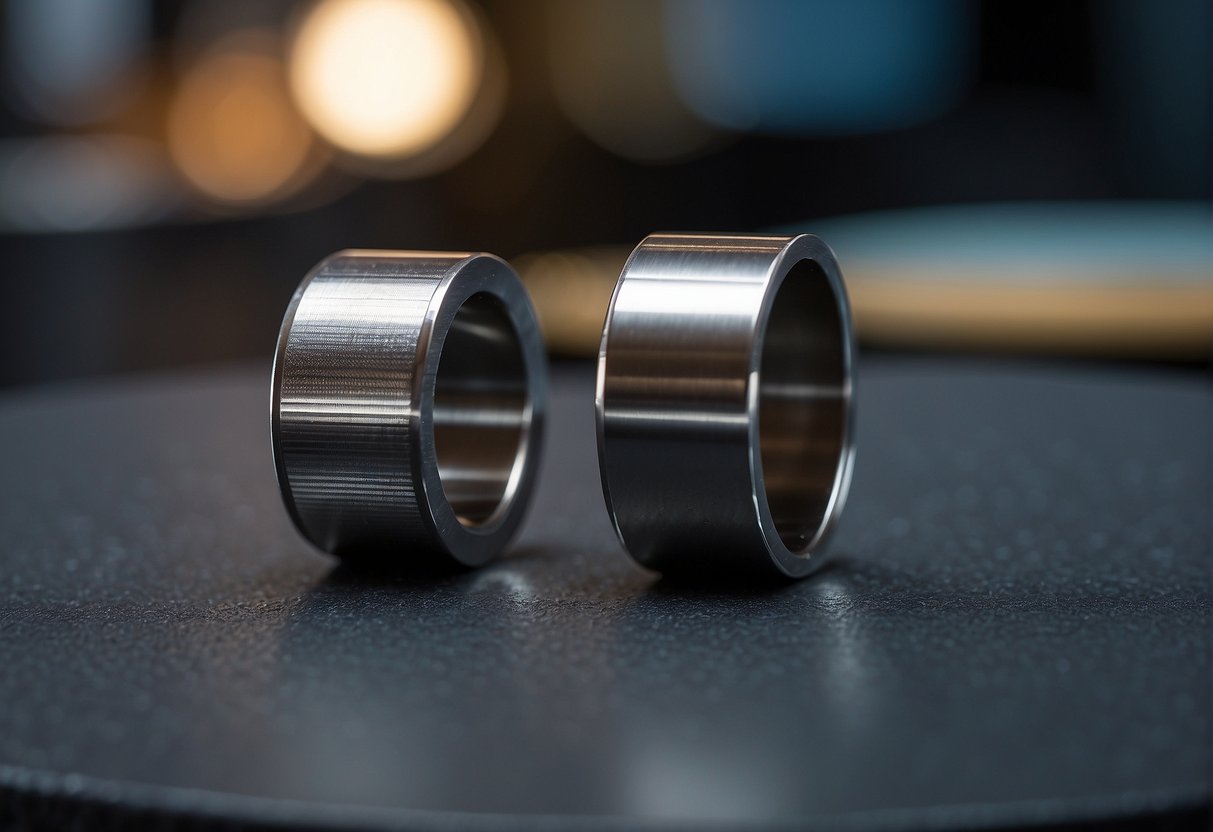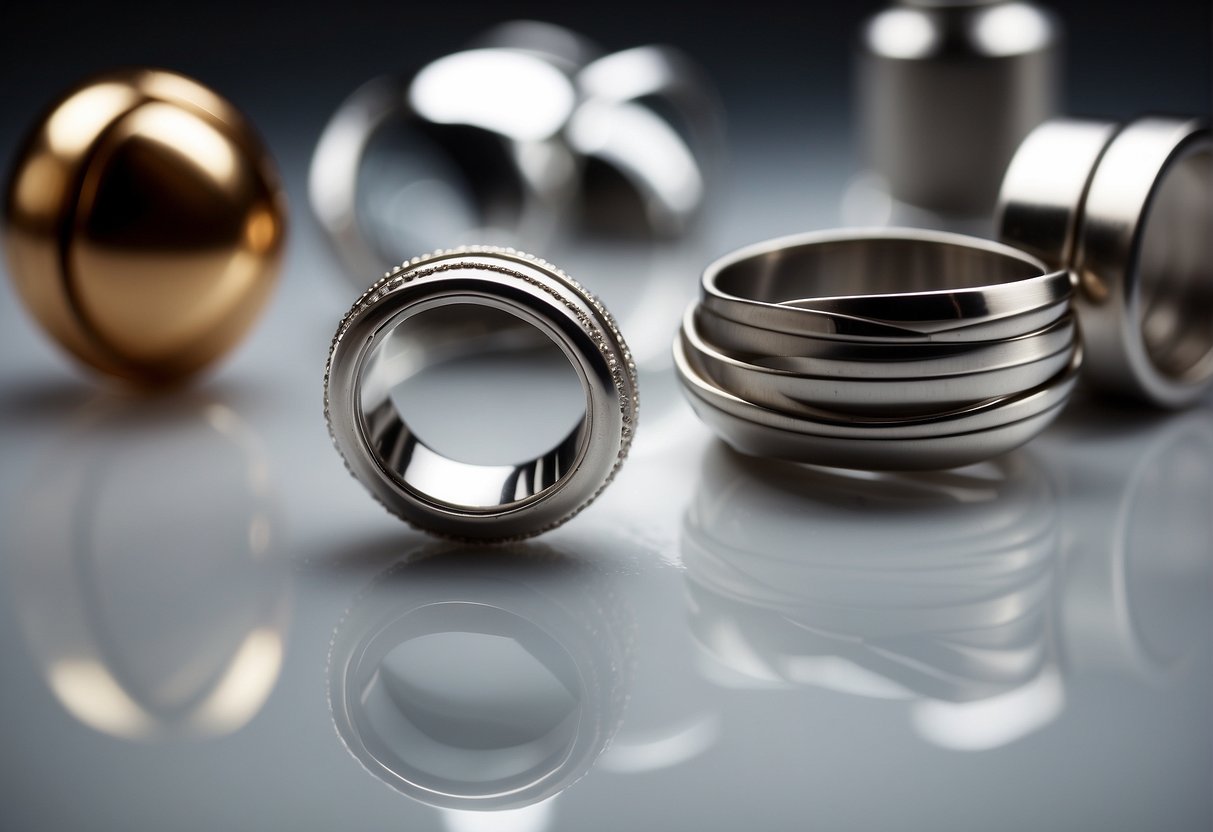How to Know if Jewellery is Stainless Steel: Quick Identification Tips
Determining if your jewellery is made from stainless steel is important, especially when quality and durability are your concerns. Stainless steel jewellery offers the advantage of resisting corrosion and oxidation, making it a highly sought-after material in jewellery crafting. It's known for its robustness and sleek appearance, often presenting as a shiny, silver-coloured metal that doesn't tarnish easily over time.

To assess if your jewellery is indeed stainless steel, pay attention to a few distinct characteristics. A quick and simple way is to check for markings such as "SS," "316L," or other numerical designations, which often indicate the grade of stainless steel used. Additionally, stainless steel can be magnetic, albeit not as strongly as iron, so bringing a magnet close to the piece can sometimes help verify its authenticity.
Furthermore, stainless steel's inherent toughness sets it apart from softer metals. For example, it's harder than silver, which scores between 2.5 and 3 on the Mohs scale of mineral hardness, while stainless steel typically rates above 5.5, making it less likely to scratch from everyday wear. Remember, while these methods can guide you, consulting with a professional jeweller can provide a definitive conclusion regarding the composition of your jewellery.
Identifying Stainless Steel Jewellery
When aiming to ascertain the authenticity of stainless steel jewellery, key tests can be applied. Each test provides insight into whether your piece is genuine stainless steel, known for its durability and resistance to corrosion, tarnish, and rust.
Magnet Test
Magnetic Attraction: Real stainless steel is typically magnetic. Use a fridge magnet to see if there's a pull. Grades like 304 or 316 stainless steel will have a slight magnetic response due to the alloy's iron content. However, if the piece is non-magnetic, it could indicate a different metal or a lower grade of stainless steel.
Acid Test
Reaction to Chemicals: Conduct an acid test using nitric acid, being cautious and wearing gloves. Place a drop on the jewellery. Authentic stainless steel won't react — showing no colour change or corrosive effect. This resistance is because stainless steel contains chromium, forming a protective layer that prevents reaction with the acid.
Visual Inspection
Surface Analysis: Inspect the colour and finish closely. Stainless steel has a silvery-grey hue and can come in different finishes such as polished (shiny), brushed (subtly textured), or matte (satin-like). Check for signs of rust, scratches, or tarnish, which stainless steel resists well, particularly in higher quality grades like 316L.
Check for Markings
Engraved Numbers: Look for stamped identifiers indicating the grade — ‘316L’ for marine-grade, offering superior resistance to corrosion, or ‘304,’ which is also common. These numbers confirm the authenticity and alloy composition. A lack of marking does not definitively mean it's not stainless steel, but it's an easy indicator when present.
Understanding the Composition of Stainless Steel

Before diving into the specifics, it's important to understand that stainless steel is an alloy consisting primarily of iron and a minimum of 10.5% chromium by mass, which provides its signature corrosion resistance. Additional elements such as nickel and molybdenum are also added to enhance specific properties.
Chromium Content
Chromium is the key element in stainless steel that reacts with oxygen to form a thin, protective layer of chromium oxide on the surface. This layer prevents further corrosion and gives stainless steel its ability to withstand harsh conditions. The standard chromium content is over 10.5%.
Role of Nickel
Nickel is often added to stainless steel to enhance its corrosion resistance, formability, and strength. Most importantly, nickel gives stainless steel its characteristic austenitic structure, making it non-magnetic and typically less prone to corrosion. Austenitic stainless steels, those with higher nickel content (about 8-10%), are especially popular for jewelry due to their non-reactive nature. If you're allergic to nickel, it's essential to seek out nickel-free stainless steel alloys.
Different Grades and Alloys
Stainless steel comes in several different grades and alloys, each tailored for specific uses. The three main types are:
- Austenitic: Contains nickel and chromium. It is the most common type used for jewelry and is usually non-magnetic.
- Ferritic: Lower in nickel content and magnetic. It's often used in industrial applications.
- Martensitic: Similar to ferritic but with higher carbon content, which provides strength and hardness.
For jewelry, austenitic stainless steel, such as grade 304 (also known as 18/8 for its composition of 18% chromium and 8% nickel) or the more corrosion-resistant 316L, is often used. The 'L' denotes 'low carbon,' which enhances its anti-corrosion properties. In pieces where enhanced resistance to pitting from chloride solutions is needed, like in marine environments, the addition of molybdenum is common.
Benefits and Drawbacks of Stainless Steel Jewellery

When you select stainless steel jewellery, you're investing in durability and style, but it's not without its limitations. It's important to weigh up these factors to make an informed decision.
Durability and Maintenance
Durability: Your stainless steel jewellery is highly resilient to wear and tear. It's made to last, resisting scratches and dents that softer metals cannot. Maintenance: Cleaning is straightforward; a bit of soap and water will maintain its lustre. Should it lose its shine, toothpaste can serve as a gentle abrasive to bring back the polished look.
Aesthetic Appeal
Finishes: Stainless steel comes in various finishes, from a high shine to a matte or brushed appearance, catering to your aesthetic preference. Quality: Despite its strength, stainless steel's rigidity can restrict intricate designs or the embedding of gemstones, which may limit your style choices to simpler forms.
Cost and Accessibility
Affordable: Enjoy the value of jewellery that's budget-friendly without sacrificing quality. Stainless steel provides an excellent balance of cost-effectiveness and durability. Accessibility: It’s readily available, making it a convenient choice for a variety of jewellery options, from rings to necklaces.
Health and Safety
Hypoallergenic: If you have sensitive skin, stainless steel is a safe bet as it’s usually hypoallergenic, minimising the risk of allergic reactions. Environmentally Friendly: Being recyclable, choosing stainless steel is not just good for you but also for the environment. Keep an eye out for nickel-free options if you're concerned about skin sensitivity or the 'green' factor.
Care and Maintenance of Stainless Steel Jewellery
Proper care ensures the longevity and lustre of your stainless steel jewellery. Here we'll explore methods to maintain its appearance and prevent damage.
Cleaning Techniques
Your stainless steel jewellery can retain its shine with routine cleaning. If you notice a loss of shine or the presence of fingerprints, it’s time to clean.
- Basic Cleaning: Prepare a solution of warm water and a few drops of mild dish soap. Soak a soft, lint-free cloth in the solution and gently wipe your jewellery. For detailed pieces, gently brush with a soft-bristled toothbrush.
- Deep Cleaning: For a more thorough clean, create a paste using baking soda and water. Apply with a soft cloth and rub gently. Rinse with warm water and dry thoroughly.
Preventing Scratches and Discoloration
To maintain the pristine condition of your stainless steel jewellery, mindful wearing and storage are important.
- Wear with Care: Even with its durability, stainless steel can scratch. Avoid wearing jewellery during heavy physical activity to prevent scratches.
- Safe Storage: Store your jewellery in a separate compartment or a soft pouch to reduce exposure to air and moisture, which can lead to tarnishing or oxidation.
- Avoid Chemicals: Contact with harsh chemicals can cause discolouration. Remove jewellery when cleaning or using things like chlorine or bleach.
Frequently Asked Questions
In this section, you'll find concise answers to common questions about distinguishing genuine stainless steel jewellery.
How can I identify a stainless steel ring?
To identify a stainless steel ring, check for a small marking or stamp often found on the inside. This mark typically reads "SS," "316L," "S.Steel," or similar variations indicating the grade of stainless steel.
What are the methods to distinguish between stainless steel and steel in jewellery?
Examining the piece with a magnet can be a quick test—stainless steel is typically non-magnetic. Additionally, stainless steel doesn't rust or corrode easily, so look for signs of wear that could indicate the presence of plain steel.
What are the signs that a piece of jewellery is actually silver and not stainless steel?
Silver jewellery often has a hallmark such as "925," "Sterling," or "Ster," signifying its authenticity. Unlike stainless steel, silver tends to tarnish, requiring regular polishing to maintain its shine.
How can I verify the authenticity of my stainless steel bracelet?
Authentic stainless steel bracelets are durable, resistant to corrosion, and have a high lustre. Look for a stamp indicating its grade, which is often "316L," as this is commonly used in high-quality stainless steel jewellery.
What visual or physical cues indicate that jewellery is genuine stainless steel?
Genuine stainless steel jewellery will have a smooth finish and a heavy feel in your hand. It should not rust or discolour over time, and scratches should be difficult to inflict due to the material's hardness.
What hallmark should I look for to confirm stainless steel in jewellery?
Look for hallmarks such as "316L," "304," or "S.Steel," which indicate the type and grade of stainless steel. These are usually engraved on a less conspicuous part of the piece.

